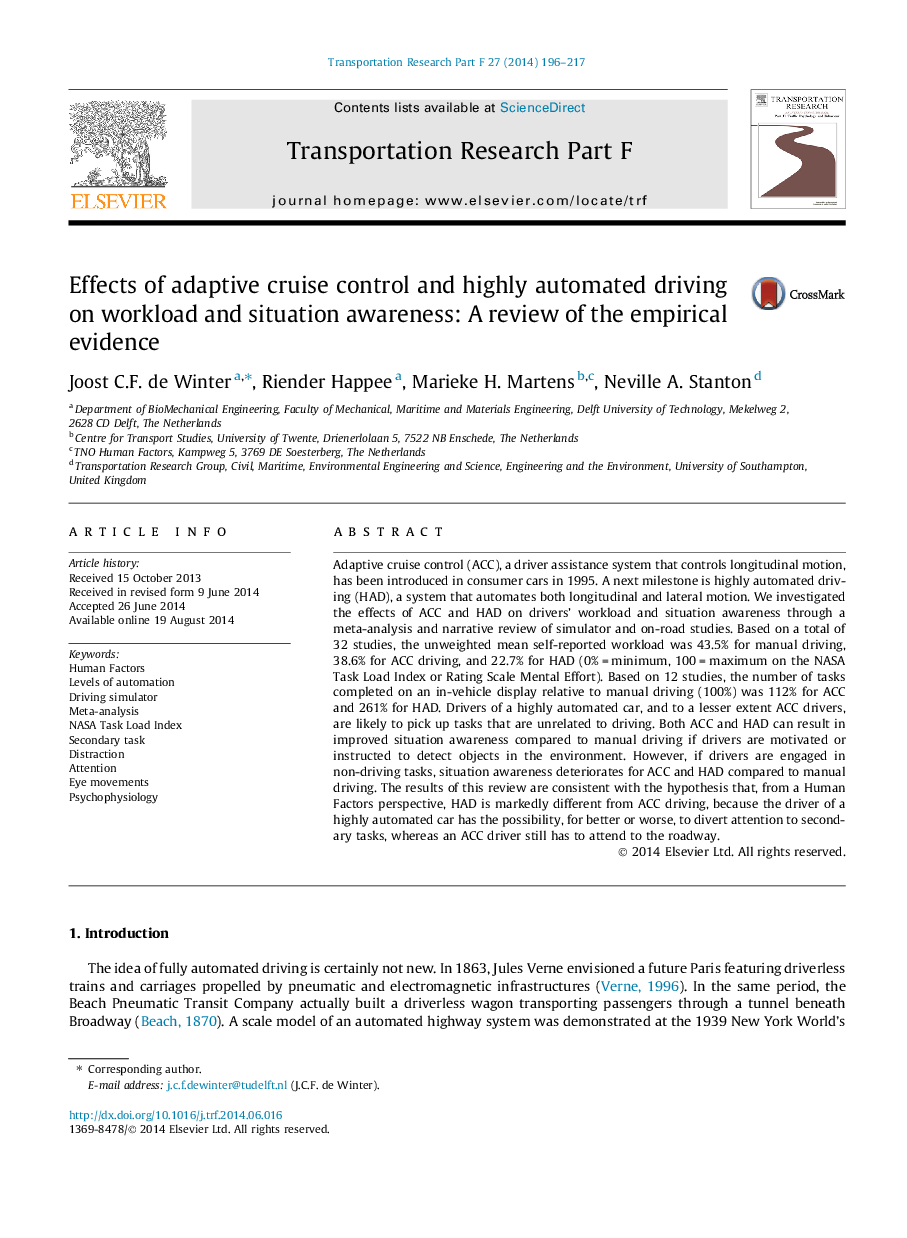| کد مقاله | کد نشریه | سال انتشار | مقاله انگلیسی | نسخه تمام متن |
|---|---|---|---|---|
| 10442931 | 915190 | 2014 | 22 صفحه PDF | دانلود رایگان |
عنوان انگلیسی مقاله ISI
Effects of adaptive cruise control and highly automated driving on workload and situation awareness: A review of the empirical evidence
ترجمه فارسی عنوان
اثرات کنترل کروز سازگار و رانندگی بسیار اتوماتیک بر میزان کار و آگاهی از وضعیت: بررسی شواهد تجربی
دانلود مقاله + سفارش ترجمه
دانلود مقاله ISI انگلیسی
رایگان برای ایرانیان
کلمات کلیدی
عوامل انسانی، سطح اتوماسیون، شبیه ساز رانندگی، متاآنالیز، شاخص بار بار کار ناسا، وظیفه ثانویه، حواس پرتی، توجه حرکات چشم، روانپزشکی،
موضوعات مرتبط
علوم انسانی و اجتماعی
روانشناسی
روان شناسی کاربردی
چکیده انگلیسی
Adaptive cruise control (ACC), a driver assistance system that controls longitudinal motion, has been introduced in consumer cars in 1995. A next milestone is highly automated driving (HAD), a system that automates both longitudinal and lateral motion. We investigated the effects of ACC and HAD on drivers' workload and situation awareness through a meta-analysis and narrative review of simulator and on-road studies. Based on a total of 32 studies, the unweighted mean self-reported workload was 43.5% for manual driving, 38.6% for ACC driving, and 22.7% for HAD (0%Â =Â minimum, 100Â =Â maximum on the NASA Task Load Index or Rating Scale Mental Effort). Based on 12 studies, the number of tasks completed on an in-vehicle display relative to manual driving (100%) was 112% for ACC and 261% for HAD. Drivers of a highly automated car, and to a lesser extent ACC drivers, are likely to pick up tasks that are unrelated to driving. Both ACC and HAD can result in improved situation awareness compared to manual driving if drivers are motivated or instructed to detect objects in the environment. However, if drivers are engaged in non-driving tasks, situation awareness deteriorates for ACC and HAD compared to manual driving. The results of this review are consistent with the hypothesis that, from a Human Factors perspective, HAD is markedly different from ACC driving, because the driver of a highly automated car has the possibility, for better or worse, to divert attention to secondary tasks, whereas an ACC driver still has to attend to the roadway.
ناشر
Database: Elsevier - ScienceDirect (ساینس دایرکت)
Journal: Transportation Research Part F: Traffic Psychology and Behaviour - Volume 27, Part B, November 2014, Pages 196-217
Journal: Transportation Research Part F: Traffic Psychology and Behaviour - Volume 27, Part B, November 2014, Pages 196-217
نویسندگان
Joost C.F. de Winter, Riender Happee, Marieke H. Martens, Neville A. Stanton,
